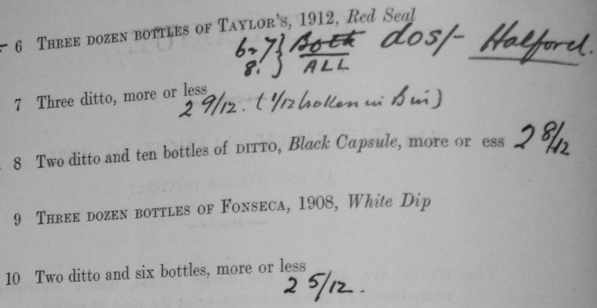Page 1 of 1
Seal, Capsule, Dip
Posted: 23:12 Fri 26 Dec 2014
by jdaw1
From an auction on 19 March 1935 by Messrs. Christie, Manson & Woods, “the Property of James Warren, Esq. late of Capel House, Waltham Cross”.
 (Reproduced by kind permission of Christie’s; my picture #22226)
(Reproduced by kind permission of Christie’s; my picture #22226)
Pray, kinds sirs, what be the difference between a colour of “Seal”, of “Capsule”, and of “Dip”?
Re: Seal, Capsule, Dip
Posted: 23:22 Fri 26 Dec 2014
by LGTrotter
Tautology, saying the same thing in different ways, iteration.
Re: Seal, Capsule, Dip
Posted: 23:32 Fri 26 Dec 2014
by AW77
I would also think that all three terms are words for just one thing. I guess that in the old days they used wax to seal the necks of bottles. So "seal" and "dip" (dipping the neck into the hot wax) would be two words for one thing.
Re: Seal, Capsule, Dip
Posted: 00:10 Sat 27 Dec 2014
by djewesbury
I suppose there could be some fine differences, but I doubt that they are important. A capsule might be rubberised rather than being wax. A dip might be less thorough a coating than a seal (or vice versa). Is it material?
Re: Seal, Capsule, Dip
Posted: 01:57 Sat 27 Dec 2014
by DRT
jdaw1 wrote:Pray, kinds sirs, what be the difference between a colour of “Seal”, of “Capsule”, and of “Dip”?
I think of a "capsule" being made of lead/tin/foil/plastic. "Seal" is a generic term for whatever is covering the cork. "Dip" is clearly wax, being the only "seal" one could apply to a bottle by dipping.
Re: Seal, Capsule, Dip
Posted: 10:11 Sat 27 Dec 2014
by djewesbury
DRT wrote:jdaw1 wrote:Pray, kinds sirs, what be the difference between a colour of “Seal”, of “Capsule”, and of “Dip”?
I think of a "capsule" being made of lead/tin/foil/plastic. "Seal" is a generic term for whatever is covering the cork. "Dip" is clearly wax, being the only "seal" one could apply to a bottle by dipping.
Quite so.
Re: Seal, Capsule, Dip
Posted: 17:14 Sat 27 Dec 2014
by LGTrotter
DRT wrote:jdaw1 wrote:Pray, kinds sirs, what be the difference between a colour of “Seal”, of “Capsule”, and of “Dip”?
I think of a "capsule" being made of lead/tin/foil/plastic. "Seal" is a generic term for whatever is covering the cork. "Dip" is clearly wax, being the only "seal" one could apply to a bottle by dipping.
Sounds about right.
I wonder if the colours are significant. In 19th century literature about wine some great wines are referred to by the colour of the wax/seal/dip. I hope I am not asked for examples as I am not sure where I have come across this.
Re: Seal, Capsule, Dip
Posted: 18:40 Sat 27 Dec 2014
by DRT
There are some colours of wax that seem to be traditionally associated with certain shippers. Two that spring to mind are Taylor >> Dark Green and Warre >> Royal Blue. Taylor VP and Warre LBV maintain the same colours in their modern foil capsules.
Re: Seal, Capsule, Dip
Posted: 21:28 Sat 27 Dec 2014
by PhilW
I would add Niepoort >> yellow to Derek's list.
Related, though somewhat off-topic, but I note that Grahams seem to have changed from their black/red/magenta colours to copper capsule and label flash for their 2009 lbv.
Re: Seal, Capsule, Dip
Posted: 22:45 Sat 27 Dec 2014
by AW77
LGTrotter wrote: I wonder if the colours are significant. In 19th century literature about wine some great wines are referred to by the colour of the wax/seal/dip. I hope I am not asked for examples as I am not sure where I have come across this.
One example could be Schloß Johannisberg in the Rheingau:
The Key to the Colors
Various colors have been used to distinguish wine qualities at Schloss Johannisberg since the days of Fürst von Metternich. Then (1820), with “Siegellack” (wax seals); today, with colored capsules
Gelblack (yellow seal): QbA
Rotlack (red seal): Kabinett
Grünlack (green seal): Spätlese
Silberlack (silver seal): 1.Gewächs (first growth)
Rosalack (pink seal): Auslese
Rosa-Goldlack (pink-gold seal): Beerenauslese
Goldlack (gold seal): Trockenbeerenauslese
Blaulack (blue seal): Eiswein
Source:
http://www.schloss-johannisberg.de/en/j ... berger.htm
Even today, people normally refer to the wines by the seals rather than the quality levels.

